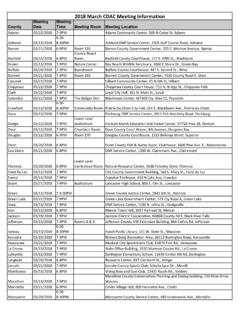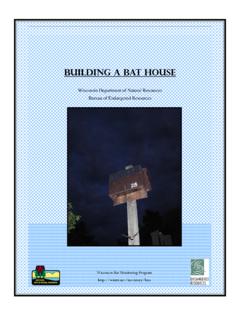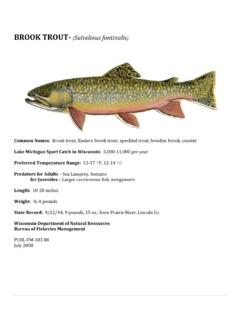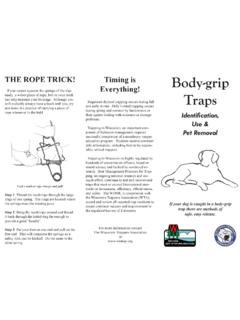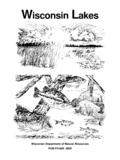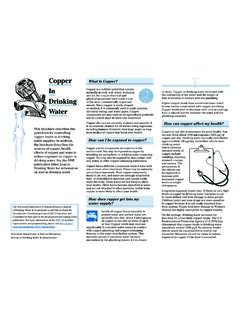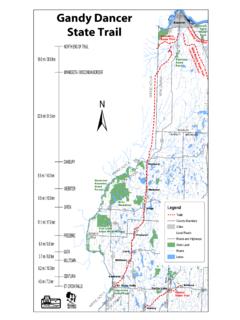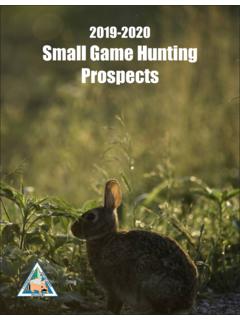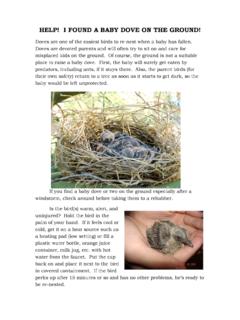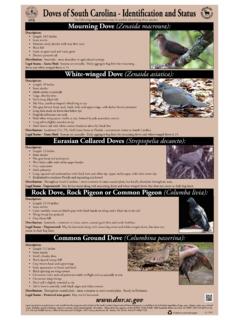Transcription of Mourning Dove Brochure - dnr.wi.gov
1 WILDLIFERESTORATIONI dentificationMourning DoveHunting InWisconsinThis publication will helpyou better understandsome of the details aboutthis new huntingopportunity includingdove biology, managementand proper you are going to hunt doves, you mustproperly identify your target or not law protects all non-hunted migratorybirds and prohibits their killing due tomisidentification. Two other birds found inmourning dove habitat you should be on thelookout for are the kestrel (sometimes calledsparrow hawk) and the killdeer. Male andfemale kestrels have different plumages, butboth have gray heads with reddish crowns ontop. Kestrels have two black marks on theirwhite cheeks that look a bit like a handle-barmustache with long sideburns.
2 Males haveblue-gray wings and a rusty back and lack the bluish wings. In flight, theundersides of the kestrel s wings appear soar on flat wings, often with their tailfanned. When hunting, kestrels frequentlyhover in one spot with rapidly beatingwings. If they are in astrong headwind,kestrels mayremain fairlystationary withtheir wingsheld steady,much like akite on a oftenchase the birdsthey pursue ina direct andrapid canoften be seensitting onexposedlookoutperches,telephonepoles or onwires. Kestrels voices are ahigh andexcited killy, killy,killy. PRINTED ON RECYCLEDPAPERPUB-WM-351-2003 RecipesFrom: Ecology and managementof the Mourning doveEasy Grilled DovesContributed by Steve Young of Columbia, MissouriWith toothpicks, pin about a third of a strip ofbacon around dove breast.
3 Cook over a cool tomedium fire for 20 to 30 minutes, but don tovercook. Sauce is in Mushroom SoupContributed by Dick Vaught of Columbia, Missouri30 dove breasts (marinated in milk)2 (10 3/4 oz.) cans of cream ofmushroom soup4 soup cans of milk (2-percent or skim)salt and pepper to tasteFlour for dredgingMarinate dove breasts for about 30 minutes inmilk (save milk). Remove doves and, while they arestill wet, roll in flour that has been seasoned withsalt and pepper. After dredging in flour, set thebreasts aside for 10 minutes or so to permit flour toadhere better to doves. Place dove breasts in a largeskillet of hot grease (Crisco shortening seems tobrown them better). Be sure each breast is fried toa golden brown. Remover the breasts and draingrease, leaving brown cracklings in skillet.
4 Replacedove breasts and cover completely with mushroomsoup and milk. Stirring frequently to preventsticking, let simmer for at least an hour (or untilmeat slides from bone). When gravy is smooth,ladle over a bed of cooked rice or mashed More Information:Ecology and management of the mourningdove. Baskett, , M. W. Sayre, R. , and R. E. Mirarchi, Stackpole Books. Harrisburg, dove. In The birds of NorthAmerica, No. 117. A. Poole and F. Gill,Editors. Philadelphia: The Academy ofNatural Sciences; Washington, : TheAmerican Ornithologist s of Conduct1. Treat every firearmas if it is loaded2. Always point themuzzle in a safedirection3. Be sure of yourtarget andbeyond4. Know the locations of your huntingpartners5. Positively identify your target and waitfor a good shot6.
5 Obey all wildlife laws and reportviolationsCompiled by the Wisconsin Department of NaturalResources, Box 7921, Madison, WI Wisconsin Department of Natural Resources providesequal opportunity in its employment, programs, services,and functions under an Affirmative Action Plan. If youhave any questions, please write to Equal OpportunityOffice, Department of Interior, Washington, publication can be made available in alternativeformats (large print, Braille, audio tape, etc) upon call 608-266-8204 for more DoveKilldeer aresmall, long-leggedshorebirdsfound inopen fieldsandpastures,often far fromwater. Look fortheir distinctivedark breast bands. Adults have two breastbands while juveniles have only one also have a rusty orange patch on theupper tail and lower back.
6 Killdeer are seldomseen in large flocks. Listen for them to whistletheir name kill-deer, kill-deer, kill-deer or ashortened dee-ee .As a responsible hunter you must familiarizeyourself with Mourning doves and other similarspecies before you begin hunting. By scoutingand being extra careful you will avoidmisidentification of these similar mourningdove looks likea slender,streamlinedpigeon, which isnot surprising since itbelongs to the samefamily of birds as thedomestic feral (or rock dove). Mourning dovesare about a foot long, ranging in size from 11to 13 inches, with males being slightly identification features are the small head,pointed wings and the long tail that graduallytapers to a point. These tail feathers show largewhite spots when the birds fly away.
7 Look forthe black spots on their upper wings, close tothe body. Doves also have a large dark spotbelow the eye. Their bill is thin and black whiletheir legs and feet are a dull red. The upperbody feathers range in color from grayish blueto grayish brown. They have grayish-brownbacks and buff-colored undersides. On brightdays, doves in flight appear gray or gray-brown, but in poor light they look are extremely swift fliers averagingabout 30-40 miles per hour, but when they arealarmed they can reach 60 miles per have a steady, rapid wingbeat in may notice that doves can make rapidchanges of pace and altitude. Listen for thenoticeable whistling sound produced by thebeating of their wings. Stephen J. Lang Stephen J. Lang Herbert Lange Scott Nielsen Stephen J.
8 LangLP/03 The Mourning dove is highly adaptable andcan be found in many different habitats fromurban settings to rural settings. Since doves loveweed seeds and waste grain, you ll often findthem feeding in harvested grain fields, oldgrassy fields, along rural roadsides or on otheropen disturbed ground that offers plenty ofseeds. You can also find doves in open woodlotsand near the edges of larger tracts of forests. Fornesting habitat, doves prefer single trees orshrubs surrounded by open land. Doves preferto roost and rest on exposed dead tree limbs,utility wires or doves are one of the most abundant,widely distributed migratory birds of our are particularly numerous south of a linerunning from Green Bay to Eau have estimated that between 4 and 5million doves migrate through Wisconsin eachfall.
9 They breed from central Canada tosouthern Mexico and in all of the 48 states inbetween. One segment of the Mourning dovepopulation breeds in Wisconsin. These dovesleave our state each fall and follow theirnatural migration route to the southern UnitedStates and Mexico. Another segment of thedove population migrates into and throughWisconsin from Canada and other states. Someof these doves winter here while the remaindermigrate through to southern wintering , Bag Limit,and RegulationsSince the Mourning dove is a migratory bird it isprotected under the Federal Migratory Bird TreatyAct. The act allows states to conduct managedhunts for Mourning doves and other are some important regulations to keep inmind while planning your hunt:A small game, sportsman s or patron slicense is needed to hunt Mourning do not need to purchase the state orthe federal migratory bird stamp ( , duck stamp ) to hunt hours are from one-half hourbefore sunrise to must plug your shotgun with a one-piece filler that cannot be removedwithout disassembling the gun.
10 It canonly accommodate 3 or fewer daily bag limit is 15 doves and thepossession limit is 30 doves. You may takeonly one daily bag limit in any one must make a reasonable effort toretrieve all doves that you kill or birds must be in your actual custodywhile in the field and cannot be given toanother person while you are in the fieldregardless of whether or not they areproperly may not put or leave migratorygame birds at any place or in thecustody of another person unless youtag the birds with your signature,address, number of birds identified byspecies, and the date you killed doves or any other game frompower lines is unethical. It may result indamage to private property which ispunishable by fines or possible , you are required to enroll in theHIP (Harvest Information Program) andcarry proof of such a complete list of hunting regulations andshooting hours refer to the Wisconsin SmallGame Hunting Regulations good relationships with the landownersin your dove hunting areas are critical to asuccessful hunt.

